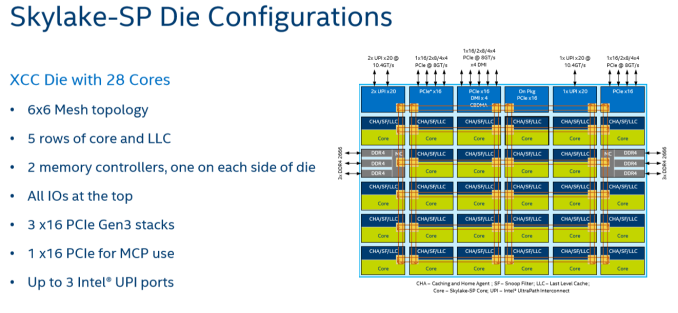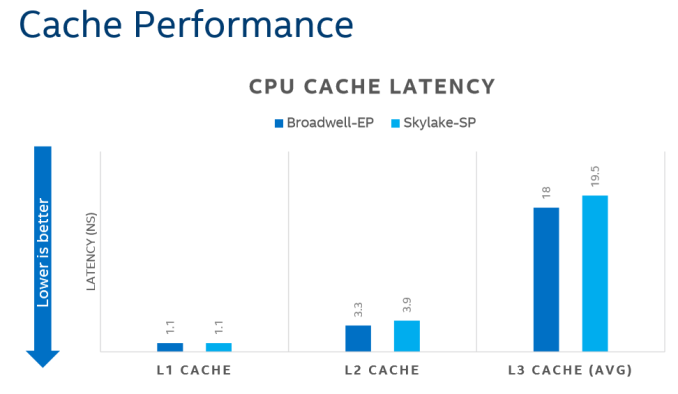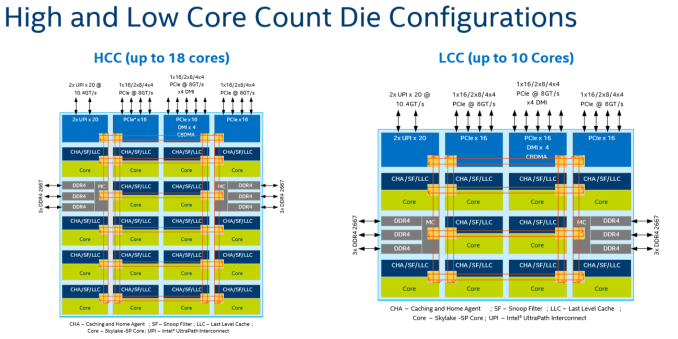Sizing Up Servers: Intel's Skylake-SP Xeon versus AMD's EPYC 7000 - The Server CPU Battle of the Decade?
by Johan De Gelas & Ian Cutress on July 11, 2017 12:15 PM EST- Posted in
- CPUs
- AMD
- Intel
- Xeon
- Enterprise
- Skylake
- Zen
- Naples
- Skylake-SP
- EPYC
Intel's New On-Chip Topology: A Mesh
Since the introduction of the "Nehalem" CPU architecture – and the Xeon 5500 that started almost a decade-long reign for Intel in the datacenter – Intel's engineers have relied upon a low latency, high bandwidth ring to connect their cores with their caches, memory controllers, and I/O controllers.
Intel's most recent adjustment to their ring topology came with the Ivy Bridge-EP (Xeon E5 2600 v2) family of CPUs. The top models were the first with three columns of cores connected by a dual ring bus, which utilized both outer and inner rings. The rings moved data in opposite directions (clockwise/counter-clockwise) in order to minimize latency by allowing data to take the shortest path to the destination. As data is brought onto the ring infrastructure, it must be scheduled so that it does not collide with previous data.
The ring topology had a lot of advantages. It ran very fast, up to 3 GHz. As result, the L3-cache latency was pretty low: if the core is lucky enough to find the data in its own cache slice, only one extra cycle is needed (on top of the normal L1-L2-L3 latency). Getting a cacheline of another slice can cost up to 12 cycles, with an average cost of 6 cycles.
However the ring model started show its limits on the high core count versions of the Xeon E5 v3, which had no less than four columns of cores and LLC slices, making scheduling very complicated: Intel had to segregate the dual ring buses and integrate buffered switches. Keeping cache coherency performant also became more and more complex: some applications gained quite a bit of performance by choosing the right snoop filter mode (or alternatively, lost a lot of performance if they didn't pick the right mode). For example, our OpenFOAM benchmark performance improved by almost 20% by choosing "Home Snoop" mode, while many easy to scale, compute-intensive applications preferred "Cluster On Die" snooping mode.
In other words, placing 22 (E7:24) cores, several PCIe controllers, and several memory controllers was close to the limit what a dual ring could support. In order to support an even larger number of cores than the Xeon v4 family, Intel would have to add a third ring, and ultimately connecting 3 rings with 6 columns of cores each would be overly complex.
Given that, it shouldn't come as a surprise that Intel's engineers decided to use a different topology for Skylake-SP to connect up to 28 cores with the "uncore." Intel's new solution? A mesh architecture.
Under Intel's new topology, each node – a caching/home agent, a core, and a chunk of LLC – is interconnected via a mesh. Conceptually it is very similar to the mesh found on Xeon Phi, but not quite the same. In the long-run the mesh is far more scalable than Intel's previous ring topology, allowing Intel to connect many more nodes in the future.
How does it compare to the ring architecture? The Ring could run at up to 3 GHz, while the current mesh and L3-cache runs at at between 1.8GHZ and 2.4GHz. On top of that, the mesh inside the top Skylake-SP SKUs has to support more cores, which further increases the latency. Still, according to Intel the average latency to the L3-cache is only 10% higher, and the power usage is lower.
A core that access an L3-cache slice that is very close (like the ones vertically above each other) gets an additional latency of 1 cycle per hop. An access to a cache slice that is vertically 2 hops away needs 2 cycles, and one that is 2 hops away horizontally needs 3 cycles. A core from the bottom that needs to access a cache slice at the top needs only 4 cycles. Horizontally, you get a latency of 9 cycles at the most. So despite the fact that this Mesh connects 6 extra cores verse Broadwell-EP, it delivers an average latency in the same ballpark (even slightly better) as the former's dual ring architecture with 22 cores (6 cycles average).
Meanwhile the worst case scenario – getting data from the right top node to the bottom left node – should demand around 13 cycles. And before you get too concerned with that number, keep in mind that it compares very favorably with any off die communication that has to happen between different dies in (AMD's) Multi Chip Module (MCM), with the Skylake-SP's latency being around one-tenth of EPYC's. It is crystal clear that there will be some situations where Intel's server chip scales better than AMD's solution.
There are other advantages that help Intel's mesh scale: for example, caching and home agents are now distributed, with each core getting one. This reduces snoop traffic and reduces snoop latency. Also, the number of snoop modes is reduced: no longer do you need to choose between home snoop or early snoop. A "cluster-on-die" mode is still supported: it is now called sub-NUMA Cluster or SNC. With SNC you can divide the huge Intel server chips into two NUMA domains to lower the latency of the LLC (but potentially reduce the hitrate) and limit the snoop broadcasts to one SNC domain.














219 Comments
View All Comments
JKflipflop98 - Wednesday, July 12, 2017 - link
For years I thought you were just really committed to playing the "dumb AMD fanbot" schtick for laughs. It's infinitely more funny now that I know you've actually been *serious* this entire time.ddriver - Wednesday, July 12, 2017 - link
Whatever helps you feel better about yourself ;) I bet it is funny now, that AT have to carefully devise intel biased benches and lie in its reviews in hopes intel at least saves face. BTW I don't have a single amd CPU running ATM.WinterCharm - Thursday, July 13, 2017 - link
Uh, what are you smoking? this is a pretty even piece.boozed - Tuesday, July 11, 2017 - link
You haven't done your job properly unless you've annoyed the fanboys (and perhaps even fangirls) for both sides!JohanAnandtech - Wednesday, July 12, 2017 - link
Wise words. Indeed :-)Ranger1065 - Wednesday, July 12, 2017 - link
If you are referring to ddriver, I agree, wise words indeed.ddriver - Wednesday, July 12, 2017 - link
Well, that assumption rests on the presumption that the point of reviews is to upsed fanboys.I'd say that a "review done right" would include different workload scenarios, there is nothing wrong with having one that will show the benefits of intel's approach to doing server chips, but that should be properly denoted, and should be just one of several database tests and should be accompanied by gigabytes of databases which is what we use in real world scenarios.
CoachAub - Wednesday, July 12, 2017 - link
It was mentioned more than once that this review was rushed to make a deadline and that the suite of benchmarks were not everything they wanted to run and without optimizations or even the usual tweaks an end-user would make to their system. So, keep that in mind as you argue over the tests and different scenarios, etc.ddriver - Thursday, July 13, 2017 - link
It doesn't take a lot of time to populate a larger database so that you can make a benchmark that involves an actual real world usage scenario. It wasn't the "rushing" that prompted the choice of database size...mpbello - Friday, July 14, 2017 - link
If you are rushing, you reduce scope and deliver fewer pieces with high quality instead of insisting on delivering a full set of benchmarks that you are not sure about its quality.The article came to a very strong conclusion: Intel is better for database scenarios. Whatever you do, whether you are rushing or not, you cannot state something like that if the benchmarks supporting your conclusion are not well designed.
So I agree that the design of the DB benchmark was incredibly weak to sustain such an important conclusion that Intel is the best choice for DB applications.